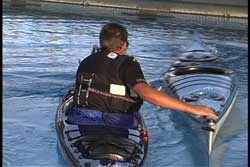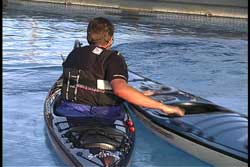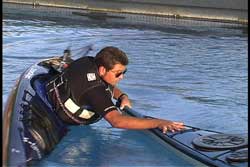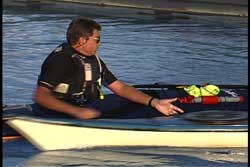
Walking A Kayak
By Wayne Horodowich
As an instructor I have been fascinated by the length of time it takes many kayakers to get from one side of their partner's boat to the other. Often I see kayakers paddle around to the other side if they need to get there. Watching kayakers swimming around their boats after a wet exit also seemed inefficient to me. Since minimizing exposure time is one of my basic goals with capsize recoveries, I tried to develop ways one could maneuver around a kayak more efficiently.
One of my better ideas came to me while horse playing with my staff. During a session of "let's flip Wayne over", I realized that once I got a hold of someone's kayak it was virtually impossible to capsize me; because of the incredible support the other kayak provided me. I also used that support to get around the boats without letting go of them. The near frictionless quality of a kayak on water moving lengthwise presents incredible advantages. As a result, I developed a technique I have called "Walking a Kayak."

The concept is simple. After you get a hold of a kayak you should never let it go unless it is time to do so. If you need to get around a kayak or reduce a paddler's immersion time here is a skill to add to your repertoire.
Whenever I approach a kayak I try to get to the bow first since water draining methods are more efficient from the bow. In any case, I grab the end of the kayak that is nearest to me. Once I have the kayak in hand, I can slide along the kayak to get to the area I need.
I put my paddle under the front deck bungee cords with the paddle to the outside, so it doesn't get caught between the two boats. Securing the paddle provides hands free operation to get around the kayak.
Using the deck lines (another great reason for deck lines) and pulling the kayak lengthwise, takes advantage of the speed at which a kayak moves on the surface. Regardless of whether the kayak is occupied or unoccupied, upright or overturned the skill is the same. The only difference you will feel is the speed at which the kayak moves. It does move easier when upright.

Your goal is to get around the kayak as quickly as possible and feel stable in the process. The key is to trust the support provided by the kayak you are holding. Do not hesitate to rest on it. I find I move faster if I rest on the other kayak as compared to being centered over my boat. It takes commitment.
Sliding along the length of the kayak is the easiest part of the skill. One strong pull and you can move your kayak from one end to the other in seconds.
This technique can also be used to help your partner mover around their kayak when they are in the water. If the swimmer is between the two kayaks and they wanted to get on the outside of their kayak, it is common for the paddler in the water to slowly swim around the kayak while keeping in contact with their kayak. While this method works, it is slow, which increases immersion time. Instead of them swimming around the kayak, you can pull their kayak out of their way while they keep in contact with your kayak. Once they are on the other side of their kayak, you can slide it back until the swimmer gets to their desired location on their kayak. Then you move your kayak to your desired location. When you master this technique, the process of a swimmer moving around a kayak becomes very fast.
In the event the paddler in the water loses contact with their kayak, you can use the same sliding concept instead of having them swim back to the kayak, if they are close enough. Slide the kayak to them and when they grab their boat pull them and the kayak back. Think of the kayak as a long pole thus increasing your reach.

When you get to the end of the kayak the quickest way to get around to the other side is lying on the end of the supporting boat so your own kayak can be put on edge. With your kayak on edge it will pivot around the supporting boat. Remember, you are pivoting your kayak around the end of the support boat. You are not trying to turn the support kayak in your hands.
I recommend using a push pull action with the two hands while you support yourself on the other kayak. Keep your hands a few feet apart to get the leverage you need. One hand is on the tip of the kayak while the other hand is reaching to the deck or a deck line. The end of the kayak will pass under the armpit of your outstretched arm as you pivot your kayak around the other kayak.
Be careful when pivoting around the stern when a rudder is present. Try using deck lines or the deck of the other kayak instead of grabbing the rudder, if the kayak is so equipped.Grabbing and using the rudder blade as a lever can bend the rudder blade or possibly damage the rudder assembly, so leave the rudder alone.

Once around the kayak, pull yourself along the length of the boat with the deck lines or any thing else you can grab. This skill can be done moving forward or moving backwards around the kayak. Master it in both directions in case you are in a situation where you can only move backwards. A great way to practice this skill is by having races with you friends.
The more time I watch paddlers performing capsize recoveries, the more I see the need to emphasize the necessity of learning how to manipulate your partner’s kayak when performing recoveries. The same skill set is used when you have to move your kayak around your partner’s boat. Movements need to be decisive and deliberate. Remember, your goal is to be able to quickly move around the kayak while supporting yourself. If the situation calls for fast movement, practicing this skill in advance will help you when you really need it.
Pictures seen above were taken from the USK Video "Capsize Recoveries & Rescue Procedures"
© Copyright USK